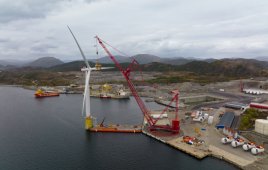This article originally appeared on WTWH Media sister site Design World. See the original version here.
Each year, roughly one out of every 200 wind turbine blades fail. Those failures pose a twofold concern for turbine owners. First, when a blade fails, there’s unplanned downtime and potential insurance issues. Second, how can blade manufacturers and turbine owners and operators feel confident that the blades on their turbine are tested adequately?
Researchers at the Technical University of Denmark (DTU) Large Scale Facility, part of Department of Wind Energy and the Villum Center for Advanced Structural and Material Testing (CASMaT), believe they have answers. The test facility, built by the Danish Building and Property Agency, opened in 2017 on the DTU Risø campus. Scientists there focus on developing new, advanced test methods to gain a better understanding of failure in large structures.
For the wind industry, testing and certifying blades to established standards is mandatory.

Inside the DTU Large Scale Facility, Moog and its partners designed and installed equipment for the three test stands. The 25-m and 45-m test stands are shown here.
“But the current version of these standards is from 2014, and it’s based on experience when turbines were much smaller,” said Dr. Kim Branner, senior research scientist and head of the Structural Design & Testing Team for DTU Wind Energy. “The standard requires a static test in four different directions and fatigue testing that makes the blade swing in two directions, exciting the blade at its natural frequency.”
According to Branner, those testing methods aren’t robust enough to mirror what happens to a blade in service. Today’s standards, he said, only test certain parts of a blade, while in reality the loads in the field are much more complicated. Branner and his team are undertaking projects to load blades in more realistic ways and to do it faster than conventional testing. The wind industry wants faster test methods, especially since bigger blades (of up to 100 m in length) have a natural frequency that’s slower. Current industry testing standards would require a manufacturer to wait up to a year to know if its blade passed the test.
DTU had a vision to develop a facility with the capability to test large-scale blades and other industrial components to help manufacturers reliably and efficiently replicate field conditions. After soliciting proposals and securing funding from the Danish government for the project, DTU picked Moog in the U.K. and its technical partners T A Savery and Qualter Hall. Moog’s expertise in aircraft structural testing and range of precision control systems, actuation products and engineering support services, which includes modelling and simulation capability, appealed to DTU’s team. Moog had already developed actuation devices specifically engineered for wind turbine blades.
“Testing is an essential element to success in the wind-energy field,” said Branner. “Moog understands that.”
The challenges of a large-scale test facility
DTU and Moog began thinking through what kind of equipment they would need to carry out more advanced tests, including bi-axial frequency tests that load a blade in different directions at the same time. From the outset, there was little if anything about the project that could be solved with commercial off-the-shelf solutions.
Moog initially undertook simulation and modelling work to demonstrate vthat its designs could meet DTU’s specification. For instance, one DTU requirement was to excite a wind turbine blade in two directions at the same time, with three test stands (ranging in size from 15 to 45 m) running simultaneously. By comparison, the wind industry’s standard blade test involves exciting a single axis, one frequency at a time. The requirement for three stands operating at once was a desire by DTU to use the facility to the fullest, which gives customers and DTU greater flexibility in testing.
“In research, we’re trying to go in new directions all the time, and it’s important to have equipment that offers flexibility,” said Branner. “We had to have a set of equipment we could use in many ways.”
Designing a solution
Moog’s expertise with closed-loop servo control and actuation helped it create a testing facility underpinned by a digital closed-loop control system and application software. To provide DTU with testing flexibility, Moog and its partners designed and installed test equipment to be used with the three test stands, which can take 15-m, 25-m and 45-m blades. Moog engineers carried out the installation and commissioning of the suite of test equipment and provided training and ongoing support for DTU staff. The Moog scope of supply for the three blade test stands included the hydraulic power plant and distribution network, six hydraulic winches for the static test and a combination of eight mass resonance exciters (MRE) and linear actuator assemblies for dynamic test work. The solution also included all pipe work, hosing and actuation devices, control system electronics and application software.
“Much analysis went into how the MRE would work, the frequency and how DTU would like it to perform,” said Graham Wood, Managing Director with T A Savery. “This was not a contract in which the customer simply said make A, B and C and that’s that. Moog won the contract, and then began a great deal of technical research, modelling and hardware design.”
In designing the facility’s equipment, Moog goal was to give DTU the latitude to conduct an array of tests. For example, if researchers wanted to use a test bay to conduct a dynamic test on a blade, the hydraulic system would accommodate wide pressure fluctuations. If the next test required a static one with winches, DTU could set the hydraulics to meet a very low flow.
“DTU can literally select what they want, without being constrained by the equipment,” said Kevin Cherrett, business segment manager for Systems and Services with Moog’s Industrial Solutions & Services group.
To design the winch assemblies, Moog tapped U.K.-based Qualter. The work included discussions about the type of rope, safety factors and mounting a hydraulic manifold on the winches, so DTU researchers can angle the winches depending on a configuration of 2, 4 or 6 load points. Competing blade-testing designs use enormous towers with winches that facility managers move with a fork truck for horizontal static testing. DTU’s winches load the blade vertically, so researchers can perform a static test to extreme loads with six winches loading a blade at six positions, while pulling the test specimen toward the floor and mimicking an extreme wind load experienced in a 100-year storm. The tip of a blade in the DTU facility can move up to 14 m, while the root of the blade moves a few centimetres. DTU wanted a facility wherein gravity and the test direction were the same. The advantage to testing a blade vertically versus sidewise with a tower is that with the latter configuration researchers have a tower that will bend during a test; this makes it difficult to control load position, plus taking up a lot of facility space when not in use.
With regard to designing the MRE, Wood and Cherrett explained that the concept was well established. But what they undertook was to develop a more robust version of that concept with flexible tools grafted onto it.
“One of the challenges of fatigue testing is ensuring you’re fatiguing the test specimen, not the equipment performing the test,” said Cherrett. “We carried out extensive tests and modelling and simulation to predict the life of the equipment; we analysed each component for life expectancy.”
In designing the actuation for the MRE, Moog included hydraulic actuator designs it had used for the aircraft industry. Within the MRE is a standard Moog actuator building block that excites the blade. The weight of the MRE was also of concern to DTU because similar devices manufactured by test houses included manifolds and piping that added mass. Working with DTU, Moog created a control manifold made from high-strength aircraft aluminium that DTU could mount anywhere.
“For every customer, with these types of systems, we seek to engage in a service level agreement, support package, preventive maintenance and tech support,” said Cherrett. “Our definition of tech support is not just a one-off exercise; we’ll be with DTU for the duration of the use of the equipment.”
Moog continues to support DTU’s work via a project in which researchers hope to see what the future holds for a working wind turbine blade. By developing sensors to embed in a blade, DTU wants to know if it can predict damage.
“Moog’s technology is helping with this because we will embed sensors in test blades with built-in defects and monitor how the damage grows,” said Branner. “The Moog exciters will put realistic loads on the blades.”
Branner sees the project helping blade makers build better blades but also creating a digitized twin of each blade that a wind farm operator could use to model what a blade’s future state might look like. If all goes according to plan, someday a wind farm control center could predict a blade fail before it happens.
More information:
http://info.moog.co.uk/DTU/DW
https://www.dtu.dk/english
Filed Under: Featured






Digital twins of each blade in a farm , how clever.